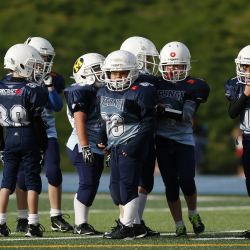A recent study of young, deceased athletes exposed to repeated head trauma revealed that 41% suffered severe Chronic Traumatic Encephalopathy (CTE), leading to their death or severe neuropsychological damage. If serious sports injuries are so prevalent, why aren’t we banning the ball?
First, there are some caveats and limitations to the study: 152 young brain donors were studied - and while 63 had CTE, a degenerative brain disorder – we have no denominator – i.e., there is no comparator regarding how many young people played contact sports overall to let us know how common this condition is in the general population. One estimate notes that 5.23 million kids play football at least once a year. This study suggests that repetitive head injuries (RHI) for a few years caused disease, not an isolated frolic.
The sports involved were diverse – including football, ice hockey, soccer, rugby, and wrestling, and most of the cohort (84%) were young amateurs, youth, high school, or college competitive.
But all, regardless of whether they had a pathologic diagnosis of CTE (which can only be diagnosed posthumously), had clinical signs and symptoms of neurological syndromes, including depression, apathy, difficulty concentrating, and decision-making issues.
Chronic Traumatic Encephalopathy (CTE)
It takes time for the neurological damage to mount and the neuroinflammatory changes to affect the player. Most deaths were neither immediate nor direct but rather behavior-related. That’s where RHI seems to wreak its havoc. All deaths reported in this nested subset of 1350 donors were under 30, and the deaths were primarily caused by suicide or unintentional overdose, hard to pin on one isolated cause.
To understand the link between CTE and serious neurological conditions, we need to take a longer-term view. Those with the most severe cases of CTE averaged age 25, with death a decade or more after their initial exposure. Other delayed conditions associated with head injury include Parkinson’s disease, and some research suggests an association with ALS (Lou Gehrig’s disease),
Perhaps most troubling is that regardless of observable brain changes, all members of this young and now dead cohort manifested neurological signs and symptoms – per surveys with next of kin. [1] The conditions included cognitive, behavioral, and mood symptoms, with 50% having clinically meaningful symptoms of executive dysfunction. But even so, we are talking about RHI – repetitive head trauma, not isolated instances, and the length of exposure (the duration of play, the level of play, and older age) played a role in the likely outcome. As the researchers write, “not all individuals exposed to RHI will develop CTE” - only 42% of them.
In July, a larger study of 631 football players corroborated the findings—those who played longer and had more RHI (or concussions) and a greater likelihood of CTE. The scary part is that these athletes, who theoretically should be in better physical shape, died on average at age 59. Yet another study found that of 111 NFL payers, 110 had CTE. Perhaps these megastars, with their mega salaries, think the risk is worth it. Let’s see.
First, let’s backtrack and look at data on concussions- isolated head injuries -- before focusing on repetitive head injuries.
“The injuries were significantly associated with increased odds of feeling sad/hopeless (adjusted OR = 1.2), suicidal ideations (adjusted OR = 1.25), suicide attempt (adjusted OR = 1.6) and suicide attempt treated by a doctor/nurse (adjusted OR = 2.35).”
– Concussions from high school sports may increase suicide risk
It seems like any sports-related head injury increases the likelihood of suicide. But other mood disorders were prevalent as well.: One large study found that 15% of high school students reported a sports-related concussion in one year.
Not surprisingly, head injuries of any type aren’t good for you. One cohort of 13,037 adults studied between 1987 and 2019 revealed that all-cause mortality was higher among those with head injuries, and the number and severity of head trauma increased the risk further.
So getting hit on the head isn’t a good idea – and having your brain rattle around within the skull isn’t “safe”. But neither are cars, planes, bikes, or elections. So, what should we do about it?
Putting the risk in context might help.
For example, let’s look at skiing.
“Ski areas across the country reported 57 fatal accidents in the 2021-22 ski season, up from 48 in the 2020-21 ski season.”
Another study of downhill skiing during the twenty years between 1980–2001 reported 149 fatal injuries, with 14% in children under 17. The youngest decedent was 7.
But here’s the kicker:
“Traumatic brain injuries were the leading cause of death (67%) among children…”
So maybe, by comparison, football isn’t so bad.
The missing denominator
A better method of assessing risk is to get the denominator right. How many people ski – how many high schoolers and college students play football? Turns out there are twice as many people who ski as people who tackle. Looks like slaloming beats tackling in terms of safety.
When it comes to high schoolers and college students, one study reported
“Football fatalities averaged 12.2 per year, or 1 per 100,000 participants.”
Not quite as bad as skiing, but we ban pesticides at that level of fatalities. And the other injuries? Sports and recreational activities contribute to approximately 21 percent of all traumatic brain injuries among American children.
But banning the ball – isn’t that a bit draconian?
One expert noted people would voluntarily accept a risk 1000 times more dangerous than one imposed on them. If adults want to ski or play football, go ahead and let them.
That hasn’t stopped ski resorts from requiring detailed informed consent and other waivers from patrons before they ascend the slopes.
“Voluntary assumption of the risk” is a legal doctrine that provides legal immunity for negligence by a proprietor or sporting director – providing all foreseeable risks are disclosed. [2] But where are these informed consent forms for kids about to join the soccer team? Who is supposed to advise them? What about the parents?
A group of veteran professional football and hockey players great football players recently convened to discuss the CTE studies. Their verdict varied. Some assuage their conscience about letting their kids play; concussion care has significantly improved since their day. The NHL now has a concussion protocol. But that doesn’t stop one football star from worrying about CTE and lamenting:
“The mental capacity side is the one thing you dread most. I wish the worst thing that I had to worry about was arthritis and joint replacement – that’d be wonderful.”
– 13-year veteran Randy Cross, SF 49ers
Another said he knew when he signed up for pro football that there was a potential of getting injuries, but not all were known to him when he first entered the league.
“Severe brain damage is not something I signed up for. ….CTE is a real issue for me on a daily basis… over time, the amount of concussions has taken a toll on my total wellness and my ability to recall data clearly most of the time… .”
- 12-year veteran Leonard Marshall, NY Giants
Yet another said:
“I’m always cognizant of the fact that I damaged my brain… I do worry and am concerned a bit about [what] the future holds.”
- 15-year veteran Keith Primeau, Detroit Red Wings and Philadelphia Flyers
What do these professional players suggest?
Randy Cross suggested that the family’s primary care provider should fill this critical role, assigning no responsibility to the team physician, coach, or specialists.
“[The doctor] has an extremely important vote in what a lot of kids do… They should not be afraid to [tell a patient] no, and not be afraid to say if playing a really violent contact sport shouldn’t happen”
Can you imagine saddling a pediatrician with the responsibility of telling her young charges, “Thou shalt not play contact sports?”
Another veteran said there is a need to raise awareness and to better educate young athletes, their parents, and healthcare providers. He makes no mention of how to do this. A third offered that uniform standards in teaching children about concussions would help diagnose and treat them.
Education is a great idea- although I’m not sure young children are ready to understand brain damage and concussions. Nor can schools throughout the US be compelled to teach the same thing- states control curriculum.
Education is crucial - for parents, teachers, and coaches, especially those coaching youth and teens in school or community-sponsored travel leagues.
What about rules reducing violent contact and better helmets? Perhaps the best education comes from a complete listing of potential hazards, providing truly informed consent, and allowing for the voluntary assumption of all reasonable risks. Then, let the parents and players decide.
Legally speaking, the onus on those providing/coaching/inviting contact sport participation would depend on the foreseeability of harm and the burden to provide some precaution. Foreseeability need not even rise to the more-probable-than-not level [3]. Given the current data, head injury and ensuing sequelae are surely foreseeable. Better helmets and stricter rules might prevent some harm. But a clear, carefully worded warning is a simple and cost-effective precaution that can be taken now.
[1] These surveys, too, might be biased, but they certainly call for further investigation.
[2] above the minimal Act-of-God level
[3] While at least one case claims suicide resulted years after a head injury, proving a causal relationship between mood disorders arising years after the injury would be trying indeed.
Source: Neuropathologic and Clinical Findings in Young Contact Sport Athletes Exposed to Repetitive Head Impacts JAMA Neurology DOI: 10.1001/jamaneurol.2023.2907

